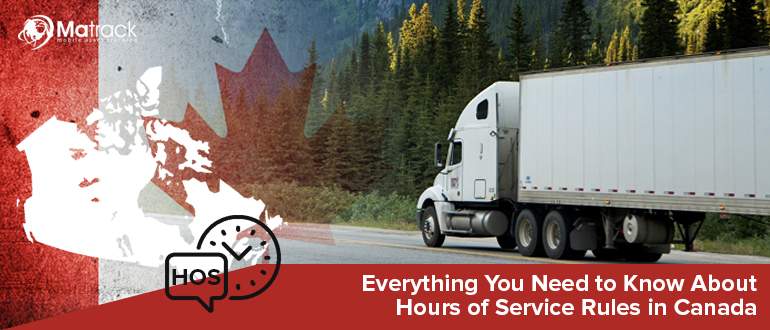Key Takeaways
- Canada’s HOS rules limit driving to 13 hours per day and require at least 10 hours of off-duty time to prevent fatigue.
- Electronic Logging Devices (ELDs) are mandatory for federally regulated drivers, with Transport Canada requiring third-party certification for compliance.
- Matrack ELD provides a certified, plug-and-play solution that ensures accurate log tracking, real-time monitoring, and effortless HOS compliance.
- Failure to comply with HOS regulations can result in heavy fines, license suspensions, and vehicle impoundments, making proper tracking essential.
Canada’s Hours of Service (HOS) regulations govern the maximum driving and on-duty hours for commercial truck and bus drivers. These rules ensure road safety by preventing driver fatigue.
The HOS regulations apply only to commercial drivers operating under Canadian federal jurisdiction and differ from U.S. HOS regulations in key areas such as maximum driving limits, off-duty time, and ELD certification.
This guide covers HOS rules, exemptions, electronic logging devices (ELDs), and penalties for violations.
What Are Canada’s Hours of Service Regulations?
The Hours of Service regulations in Canada are designed to prevent driver fatigue and ensure compliance with safe driving limits. These rules are enforced by Transport Canada under the Commercial Vehicle Drivers Hours of Service Regulations.
Who Must Comply?
HOS rules apply to commercial drivers operating federally regulated motor carriers, including:
- Trucks with a gross vehicle weight exceeding 4,500 kg (9,921 lbs)
- Buses designed to transport more than 10 passengers (including the driver)
Who Is Exempt?
Some drivers are exempt from HOS regulations, including:
- Short-haul drivers operating within 160 km of their home terminal and returning daily
- Emergency service vehicles
- Certain farming and agricultural vehicles
- Intraprovincial drivers, who follow provincial or territorial regulations
Daily and Weekly Driving Limits
Canada’s HOS rules limit driving hours per day and week to prevent fatigue-related accidents.
Daily Limits
- Maximum driving hours: 13 hours in a 24-hour period
- Maximum on-duty hours: 14 hours (includes driving and all work-related tasks)
- Mandatory off-duty hours: 10 hours total, including:
- At least 8 consecutive hours of rest
- 2 additional hours, which may be split
Work-Shift Rules
- Work shift duration: Drivers cannot exceed 16 hours from the start of their shift before taking a mandatory rest period.
Weekly Cycle Limits
Drivers must choose between two cycle options:
- Cycle 1: Maximum of 70 on-duty hours over 7 days
- Cycle 2: Maximum of 120 on-duty hours over 14 days (with a mandatory 24-hour off-duty break before exceeding 70 hours)
Reset Options:
- Cycle 1: Reset to zero after 36 consecutive off-duty hours
- Cycle 2: Reset to zero after 72 consecutive off-duty hours
Off-Duty and Rest Period Requirements
Mandatory Rest Periods
To ensure driver well-being, HOS rules require:
- At least 8 consecutive hours of off-duty time daily
- 2 additional off-duty hours, which may be split into multiple breaks
Sleeper Berth Provisions
Drivers using a sleeper berth may split their off-duty time as long as:
- Each period is at least 2 hours
- The total combined time equals at least 10 hours
- The time spent in the berth does not reduce daily rest requirements
Electronic Logging Device (ELD) Mandate
What Are ELDs?
An Electronic Logging Device (ELD) is a digital system that automatically records driving hours to ensure compliance with HOS rules. ELDs replace traditional paper logbooks and improve record accuracy.
Canada’s ELD Mandate
As of June 12, 2021, Transport Canada mandated ELD use for federally regulated carriers, with full enforcement from January 1, 2023. Unlike the U.S. self-certification model, Canada requires third-party certified ELDs to ensure accuracy and compliance.
Who Needs an ELD?
All federally regulated commercial drivers must use certified ELDs, except:
- Drivers operating under the short-haul exemption
- Vehicles manufactured before 2000
- Drivers working under an HOS permit
Key Benefits of ELDs
- Prevents logbook tampering
- Reduces administrative work
- Improves enforcement efficiency
- Minimizes human errors in tracking driving hours
Special HOS Rules for Different Conditions
Adverse Driving Conditions
Drivers can extend driving time by up to 2 hours if they encounter unpredictable conditions such as:
- Severe weather (snowstorms, floods, etc.)
- Road closures or accidents
- Traffic delays due to unforeseen events
Note: This extension only applies if it does not exceed the 16-hour work shift limit.
Oilfield Operations
Certain oilfield drivers are exempt from regular HOS rules due to long standby periods. These drivers:
- Must log waiting time as off-duty
- Can have modified work-rest schedules
North of 60° (Northern Canada) Rules
Drivers operating above the 60th parallel have different rules:
- Maximum driving time: 15 hours
- Maximum work shift: 20 hours
- Mandatory off-duty time: 8 consecutive hours
Penalties for HOS Violations
Non-compliance with HOS regulations leads to fines, license suspensions, or vehicle impoundment. Common violations include:
- Exceeding maximum driving hours
- Failing to take mandatory rest breaks
- Using unauthorized log modifications
- Not using a certified ELD (if required)
HOS Violation Penalties
- First-time offenses: Fines from $300 to $2,000
- Repeat offenses: Higher fines and possible out-of-service orders
- Severe violations: Suspension of operating licenses or criminal charges
HOS Compliance Best Practices
Use Certified ELDs
Ensure that your ELD is Transport Canada-certified to avoid compliance issues.
Plan Rest Breaks in Advance
Schedule driving shifts with adequate breaks to prevent violations.
Keep Logbooks Up to Date
Drivers must accurately record their hours in ELDs or paper logs (if exempt).
Train Drivers on HOS Rules
Regular training helps avoid violations and ensures safe operations.
Monitor Compliance with Fleet Management Software
Fleet operators should track real-time driver hours using automated compliance tools.
Matrack ELD: A Reliable Solution for HOS Compliance

Matrack ELD makes HOS compliance effortless by automatically tracking driving hours and preventing violations. The system helps drivers stay compliant with Transport Canada’s regulations while reducing paperwork and administrative work.
Setting up the Matrack ELD is quick and hassle-free—just plug it in, and you’re good to go. It works with all types of vehicles, providing real-time tracking, automated logs, and instant alerts to help drivers manage their time on the road.
Fleet managers can handle compliance tasks in just one click with the Matrack Fleet Manager Dashboard. From HOS reports and IFTA filings to safety audits and DOT inspections, everything is streamlined—no extra costs, no hidden fees, just smooth operations.
Conclusion
Canada’s Hours of Service (HOS) regulations are designed to prevent driver fatigue and enhance road safety. Commercial truck and bus drivers must comply with daily, weekly, and off-duty requirements, while Electronic Logging Devices (ELDs) are mandatory for most operators. Unlike the U.S., Canada enforces stricter ELD compliance through third-party certification.
Understanding HOS rules, exemptions, and compliance strategies is crucial for both drivers and fleet managers to maintain safe and legal operations.






